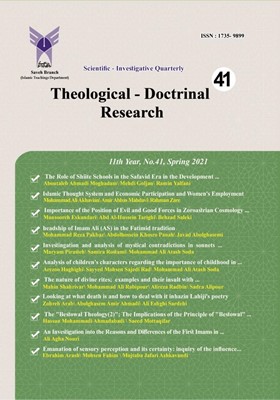-
-
List of Articles
-
Open Access Article
1 - The Role of Shiite Schools in the Safavid Era in the Development of Islamic Culture and Civilization (Emphasizing on the two schools of Khan Shiraz and the Chahar Bagh of Isfahan)
Aboutaleb Ahmadi Moghaddam mahdi goljan ramin yalfani -
Open Access Article
2 - Islamic Thought System and Economic Participation and Women's Employment
Mohammad Ali Akhavian amirabas madavifard rahman zare -
Open Access Article
3 - Importance of the Position of Evil and Good Forces in Zoroastrian Cosmology and Anthropology
Mansooreh Eskandari And Al_Hussein Tarighi Behzad Saleki -
Open Access Article
4 - headship of Imam Ali (AS) in the Fatimid tradition
Mohammad Reza Pakbaz Abdolhossein Khosro Panah Javad Abolghasemi -
Open Access Article
5 - Investingation and analysis of mystical contradictions in sonnets of Asiri Lahiji
Maryam Pirasteh samera rostami Mohammad Ali Atash Soda -
Open Access Article
6 - Analysis of children's characters regarding the importance of childhood in Attar's Tazkereh al-Awliya
arezo hagigi seyed mohsen sajedirad mohamad ali atashsowda -
Open Access Article
7 - The nature of divine rites; examples and their insult with the focus on verse 2 of Surah Ma'idah
Mahin SHahrivar Mohammad Ali Rabbipour Alireza Radbin Sadra Alipour -
Open Access Article
8 - Looking at what death is and how to deal with it inhazin Lahiji's poetry
zohreh arab Abol-Ghasem Amir-Ahmadi Ali Eshghi Sardehi -
Open Access Article
9 - The "Bestowal Theology(2)"; The Implications of the Principle of "Bestowal" in divine Attributes and acts
hasan Mohamadi ahmad abadi saeed motaqi far -
Open Access Article
10 - An Investigation into the Reasons and Differences of the First Imams in Determining the Nobles of the Imam
ali aghanoori -
Open Access Article
11 - Emanation of sensory perception and its certainty: inquiry of the influence of the Stoics on Mulla Sadra
Ebrahim Arash Mohsenn Fahim Mojtaba Jafari ashqavandi
-
The rights to this website are owned by the Raimag Press Management System.
Copyright © 2017-2025







